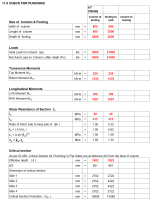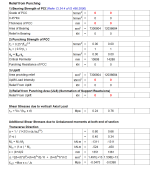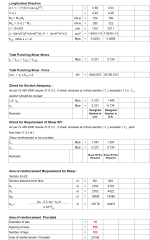Punching check as per IS-456-2000

Description
IS 456:2000 is an Indian Standard code of practice for the design of plain and reinforced concrete structures. It covers various aspects of concrete design, including the punching shear check. Punching shear is a type of failure that occurs in flat slabs or footings around columns or other concentrated loads, where the concrete is subjected to high localized shear stresses.
As per IS 456:2000, the punching shear check should be carried out using the following steps:
-
Identify the critical sections: The critical sections for punching shear are usually located at a distance of d/2 from the column or concentrated load's face, where d is the effective depth of the slab or footing.
-
Calculate the shear force: Determine the total shear force acting on the critical section. This force can be calculated by considering the factored loads from the columns or other concentrated loads, as well as any additional loads, such as soil pressure or self-weight of the slab.
-
Calculate the punching shear stress: Divide the total shear force by the area of the critical section to obtain the punching shear stress. The area of the critical section can be determined as the product of the perimeter of the critical section and the effective depth (d) of the slab or footing.
-
Determine the permissible punching shear stress: Calculate the permissible punching shear stress for the concrete as per the guidelines provided in IS 456:2000. The permissible punching shear stress depends on factors such as the grade of concrete, the percentage of reinforcement, and the location of the critical section (interior, edge, or corner).
-
Compare the punching shear stress: Compare the calculated punching shear stress with the permissible punching shear stress. If the punching shear stress exceeds the permissible value, the slab or footing may fail due to punching shear, and design modifications or reinforcements may be required.
-
Design punching shear reinforcement (if required): If the punching shear stress exceeds the permissible value, it may be necessary to provide punching shear reinforcement in the form of shear studs, stirrups, or other approved methods. The reinforcement should be designed to resist the excess shear force, ensuring that the combined capacity of the concrete and reinforcement is adequate to resist the applied loads.
In summary, the punching shear check as per IS 456:2000 involves identifying the critical sections, calculating the shear force and punching shear stress, determining the permissible punching shear stress, comparing the stresses, and designing punching shear reinforcement if required. By following these steps, you can ensure that your concrete slab or footing design meets the requirements of the code and provides adequate resistance against punching shear failure.
IS 456:2000 is an Indian Standard code of practice for the design of plain and reinforced concrete structures. It covers various aspects of concrete design, including the punching shear check. Punching shear is a type of failure that occurs in flat slabs or footings around columns or other concentrated loads, where the concrete is subjected to high localized shear stresses.
As per IS 456:2000, the punching shear check should be carried out using the following steps:
-
Identify the critical sections: The critical sections for punching shear are usually located at a distance of d/2 from the column or concentrated load's face, where d is the effective depth of the slab or footing.
-
Calculate the shear force: Determine the total shear force acting on the critical section. This force can be calculated by considering the factored loads from the columns or other concentrated loads, as well as any additional loads, such as soil pressure or self-weight of the slab.
-
Calculate the punching shear stress: Divide the total shear force by the area of the critical section to obtain the punching shear stress. The area of the critical section can be determined as the product of the perimeter of the critical section and the effective depth (d) of the slab or footing.
-
Determine the permissible punching shear stress: Calculate the permissible punching shear stress for the concrete as per the guidelines provided in IS 456:2000. The permissible punching shear stress depends on factors such as the grade of concrete, the percentage of reinforcement, and the location of the critical section (interior, edge, or corner).
-
Compare the punching shear stress: Compare the calculated punching shear stress with the permissible punching shear stress. If the punching shear stress exceeds the permissible value, the slab or footing may fail due to punching shear, and design modifications or reinforcements may be required.
-
Design punching shear reinforcement (if required): If the punching shear stress exceeds the permissible value, it may be necessary to provide punching shear reinforcement in the form of shear studs, stirrups, or other approved methods. The reinforcement should be designed to resist the excess shear force, ensuring that the combined capacity of the concrete and reinforcement is adequate to resist the applied loads.
In summary, the punching shear check as per IS 456:2000 involves identifying the critical sections, calculating the shear force and punching shear stress, determining the permissible punching shear stress, comparing the stresses, and designing punching shear reinforcement if required. By following these steps, you can ensure that your concrete slab or footing design meets the requirements of the code and provides adequate resistance against punching shear failure.
Calculation Preview
Full download access to any calculation is available to users with a paid or awarded subscription (XLC Pro).
Subscriptions are free to contributors to the site, alternatively they can be purchased.
Click here for information on subscriptions.



